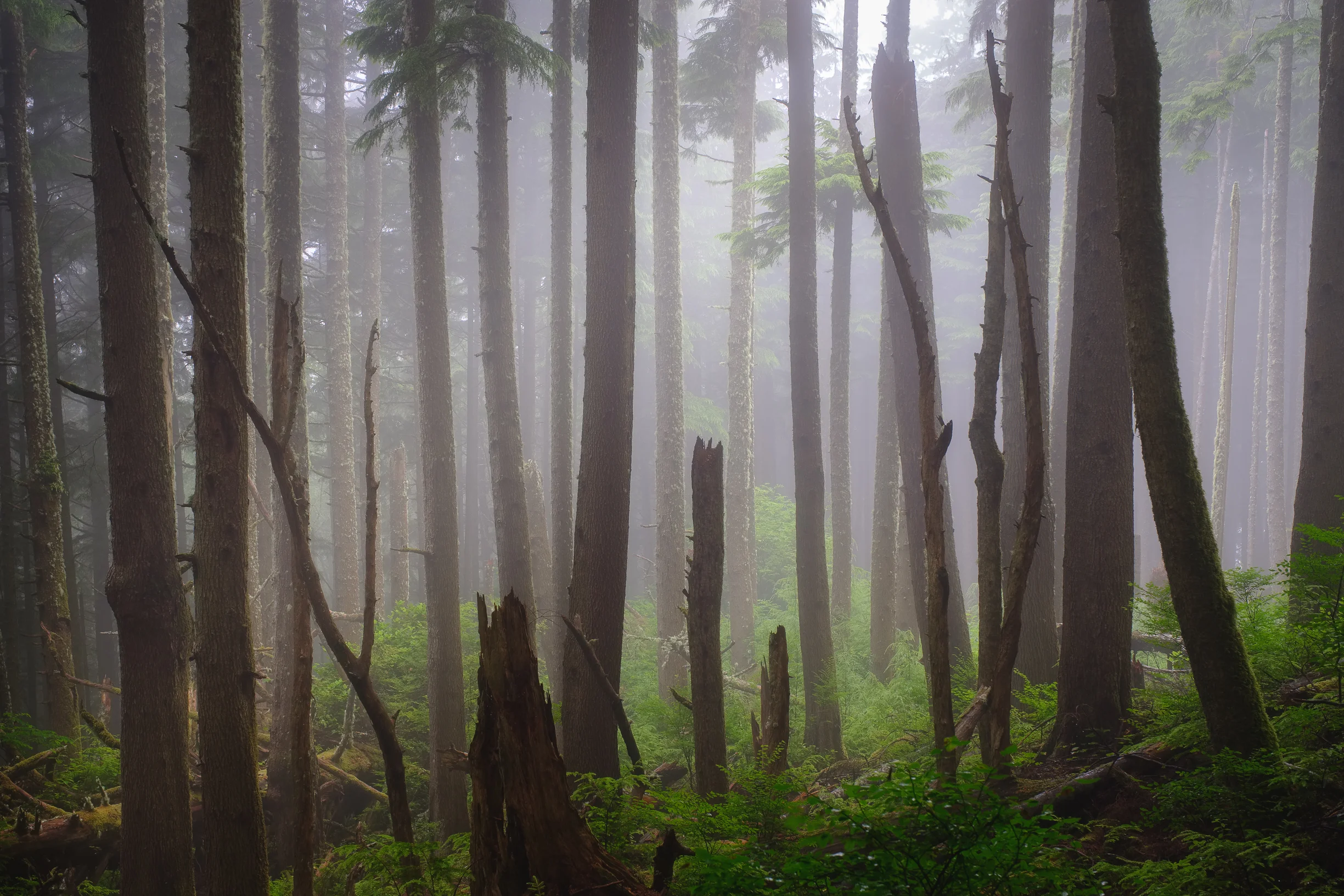Over the last year or so I have been working on my photography in more complicated scenes in order to improve my compositions and eye for finding them. The abstracts and intimate scenes apart from photographing sweeping vistas. One of the best places for this type of photography happens to be in the forest and while this works well, I have found that it can sometimes be too cluttered.
The cluttered forest has its own benefits because making even the slightest sense of it can create an impact. It also forces you to be very deliberate in where you place the tripod because an inch off or using the wrong focal length can change the compositions significantly!
Finding success in the chaos has been both fun and extremely frustrating. I admit to more failures on occasions when I go out to shoot than I care to admit. (It is a lot!) This also causes me to feel more worn out as a landscape photographer because I feel discouraged during long droughts without a good image being produced.
On the bright side, I have narrowed down on some key components that are helpful in both keeping my spirits up and capturing more quality images. In list form they are quality of light, setting a mood, decluttering, and dedicated scouting trips. Diving into each will help shine a light on what makes each important and valuable in application to your own photography.
Quality of Light
The quality of light is something we can talk about in any style of photography, but in landscape photography, it takes on its own form. Even more specific to landscape photography in forests we can be looking for a variety of conditions depending on the subject. You read that correctly, by the way, conditions in pertaining to weather and how it impacts that quality of light we get to record as photographers!
In a forest, we are already going to naturally have less light because of the canopy blocking out most direct rays. On a sunny day this creates a lot of dappled light which can be challenging, but shooting directly into the sun and getting a starburst or catching beams of light can be a pleasing effect. Otherwise, clear days can be good for side-lighting subjects in the early morning hours or leaving them to be scouting days for compositions.
Cloudy days can be solid opportunities for forest photography when other genres of landscape photography are not advisable. The flat lighting that is typically not flattering on grand vistas make smaller intimate scenes and forests easier to shoot in. Actually, just after or during the rain can add in a sheen to the foliage that along with flat light and a polarizer you can really control the depth and dimension of the image!
Mornings tend to be the best time in forests for two reasons. For one, they tend to be less busy and enjoyable on your own. Secondly, and more pertinent to the subject-at-hand, you are more likely to get good light. Soft pre-sunrise light and post-sunrise side-light are fantastic. Better-yet you are more likely to be able to catch fog! Foggy forests allow for soft and even light along with an atmosphere that limits visibility helping to simplify a chaotic scene and set you up for creating a compelling mood.
Setting a Mood
Speaking of mood, this is another very important part of forest photography. Each forest has its own story and something it can communicate. Spending a significant amount of time in the location really helps make it easier to understand what that is, and visiting across a wide variety of conditions will also help. Creating a cohesive mood with the scene and conditions and processing makes for the best forest landscape photography.
This may mean an optimistic feeling backlit tree in full fall color, or it might be a small field of stumps in a fog feeling somber for what was. Figuring out what mood the subject and you are trying to convey will be is a prerequisite for planning out a shot-list. Rarely will I show up at a spot the first time and get the right conditions, composition, and subject all put together. It takes time!
Decluttering
Composition is one of the tougher parts of forest photography. You can’t read a book on it or just look at other’s work to figure it out. There aren’t really any “iconic” shots that you can go out and get started with either. The best thing you can do is figure out what things you like about other’s work and try going for those elements. Some ideas of ‘elements’ that I might look for are uniformity, symphonic chaos, order, struggle, aloneness, etc…
Forest scenes are also difficult to make sense of many times because of the inherent clutter they have. Nature shouldn’t be controlled and things likely won’t grow or fall exactly where you want them all the time. Some may approach the solution to this as being that of moving or removing things to fit their needs. I disagree because that ruins the illusion of nature being natural for me. It also removes the challenge of making it work! I prefer to make it a challenge to work around these sorts of things and if the clutter ruins the image I simply won’t photograph it.
One can either embrace the clutter or work around it. While I appreciate the natural clutter I don’t like it to show up in my images because I have yet to make it work. I have seen many make beautiful images of the clutter though such as Hans Strand’s and Simon Baxter’s work. I prefer to find creative ways of exploding it or deemphasizing it in a way to draw focus away from the chaos.
Scouting Trips
Going out to practice photography used to mean trying to get an image I could print or sell every time. This meant I could wait for a beautiful sunset and just show up. Forest photography isn’t so simple because you don’t know what you are going to get as far as lighting goes or what you need until you are there. Also, there isn’t a book of iconic images to read for each forest hike you can go on!
The old mindset of trying to get an image on every occasion is just unhealthy to have in forest photography because of how much more often you are likely to go home without anything. So, I have built in the expectation of going on scouting trips to find out how a location looks first to learn what compositions might exist, the light they might look good in, and plan out a shot list.
Wrapping Up
Landscape photography is a wide practice with forest photography being a challenging subject to undertake. It is much more challenging and therefore rewarding than I could have ever imagined it to be when starting out. All-together, it may be the most difficult thing I have done in photography because how miserably you can fail if the final image misses the mark. When it does connect, however, the result makes the extra effort worth every ounce of blood, sweat, and tears.












